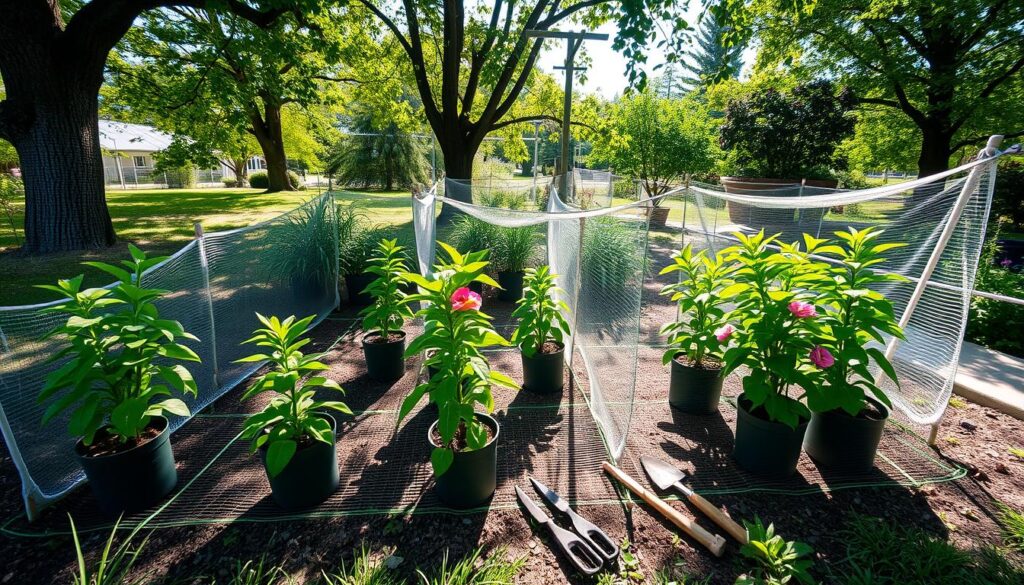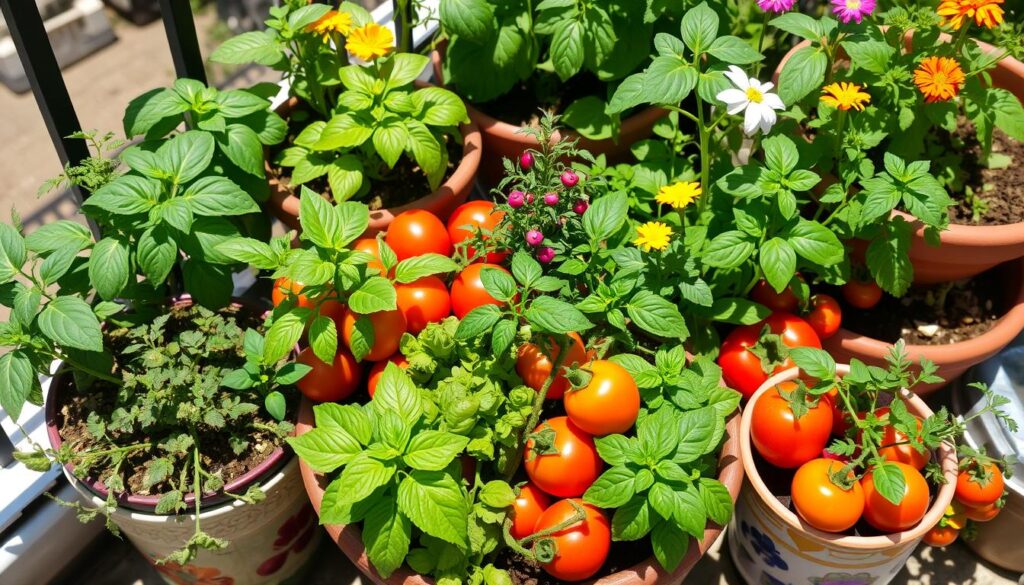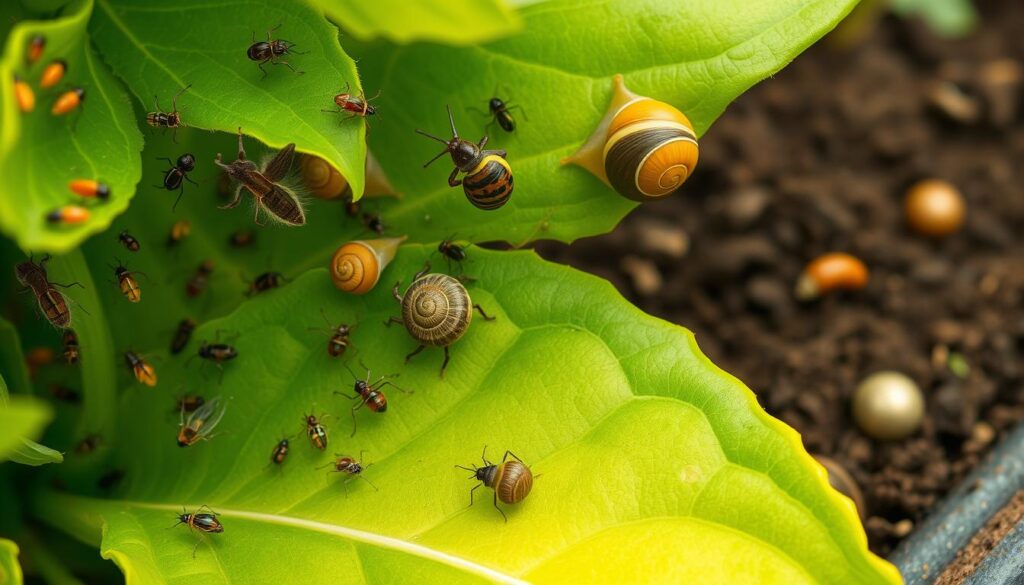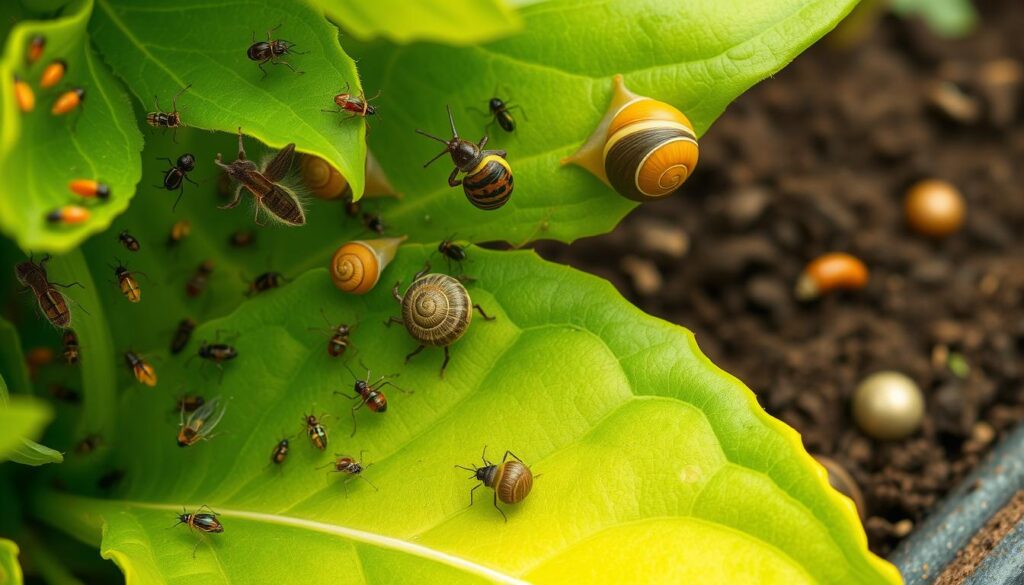Did you know that container plants are mostly pest-free compared to in-ground plants? This might sound like a dream for gardeners. But, container plants can still get pests like spider mites, aphids, and whiteflies. Fungus gnats and thrips can also be a problem.
As someone who loves container gardening, I’ve found it’s key to prevent and manage pests. This keeps your garden healthy and thriving.
Key Takeaways
- Container plants are less prone to pests than in-ground plants, but can still experience infestations
- Common container plant pests include spider mites, aphids, whiteflies, fungus gnats, and thrips
- Buying healthy plants from accredited nurseries can help prevent the introduction of pests
- Quarantining and treating new plants is essential to stop the spread of pests
- Using clean materials and avoiding reused potting soil can minimize the risk of infestations
Introduction to Container Garden Pests
Container gardening is easy and doesn’t need much care. But, it’s not safe from pests. Plants in containers can get infested with spider mites, aphids, whiteflies, fungus gnats, and thrips. These pests can spread fast in a small space, often without being noticed until it’s too late.
Common Pests in Container Gardens
- Spider Mites: These tiny arachnids feed on the sap of leaves, causing discoloration and webbing that can quickly damage plants.
- Aphids: These small, soft-bodied insects can quickly reproduce and infest container plants, sucking the life out of them.
- Whiteflies: These tiny, white flying insects feed on the undersides of leaves, leaving a sticky residue and stunting plant growth.
- Fungus Gnats: The larvae of these small flies can burrow into the soil, feeding on plant roots and causing wilting and stunted growth.
- Thrips: These slender insects feed on the leaves and flowers of plants, causing discoloration, distortion, and reduced yields.
Why Container Plants are Vulnerable to Pests
Container plants face more pest problems for a few reasons. First, pests can spread quickly in a small space. Also, plants in containers are often near our eyes, making it easier to spot pests. Lastly, the soil mix in containers might not fight pests as well as garden soil does.
| Pest | Description | Damage to Container Plants |
|---|---|---|
| Spider Mites | Tiny arachnids that feed on plant sap | Discoloration, webbing, and defoliation |
| Aphids | Small, soft-bodied insects that suck plant sap | Stunted growth, leaf distortion, and disease transmission |
| Whiteflies | Small, white flying insects that feed on leaves | Sticky residue, stunted growth, and reduced yields |
| Fungus Gnats | Fly larvae that feed on plant roots | Wilting, stunted growth, and root damage |
| Thrips | Slender insects that feed on leaves and flowers | Discoloration, distortion, and reduced yields |
“Unlike plants grown in-ground, container plants are mostly pest-free, making them ideal for low-maintenance gardening. However, that doesn’t mean container plants don’t get pests.”
Buy Healthy Plants from Accredited Nurseries
Starting a pest-free container garden begins with choosing the healthiest plants. Nurseries run by experienced gardeners offer the best plants. These plants are vigorous and resistant to pests.
Healthy plants can fight off pests like aphids and slugs. Look for signs of pests, such as discolored leaves or webbing, before buying. This helps prevent pest problems.
Using organic pest control methods like neem oil is also helpful. But starting with pest-free plants is key. Adding herbs like basil or marigolds can also deter pests.
Choosing plants from reputable nurseries is crucial for a thriving garden. This way, you can focus on caring for your plants. Enjoy the fruits of your labor all season long.
Quarantine and Treat New Plants
As a responsible plant parent, it’s crucial to take proactive measures when introducing new plants to your container garden. Quarantining and treating new plants is an essential step in preventing pest infestations and ensuring the health of your entire plant collection.
Steps for Treating New Plants
When you bring home a new plant, it’s recommended to separate it from your existing plants for a few weeks. This quarantine period allows you to closely inspect the plant and address any potential issues before integrating it with your established container garden. Here’s a step-by-step guide on treating new plants:
- Remove the plant from its original pot and gently wash the roots with water to remove any old soil.
- Carefully examine the leaves and stems for signs of pests, such as aphids, spider mites, or scale insects. Treat any infestations with a neem oil solution or other organic pesticides.
- Repot the plant in fresh, sterile potting soil to eliminate the risk of introducing pests or diseases from the previous container.
- Monitor the plant closely over the next few weeks, checking for any changes or signs of stress. Adjust watering and lighting as needed to ensure the plant’s optimal growth.
By taking the time to quarantine and treat new plants, you can significantly reduce the chances of pest infestations in your container garden, helping to maintain the health and beauty of your plants.

Remember, prevention is key when it comes to managing pests in your container garden. Stay vigilant, and don’t be afraid to take the necessary steps to protect your beloved plants.
Use Clean Materials for Planting
Starting a clean container garden means using the right stuff. It’s key to clean and disinfect your tools and containers often. This stops pests and diseases from spreading.
Cleaning and Disinfecting Containers
Before you plant new seedlings, clean and disinfect your containers well. Use warm soapy water and a stiff brush to get rid of dirt and old plant bits. Then, rinse them well and disinfect with a diluted methylated spirits solution or a commercial one. This kills off pests and diseases that could harm your new plants.
Avoiding Reused Potting Soil
Don’t reuse potting soil in your garden. Old soil can have pests or diseases in it. It might even have insect eggs or harmful germs. Use fresh, good-quality potting mix for every new planting. This gives your plants the nutrients they need and keeps pests and diseases away.
“Keeping your gardening materials clean and using fresh potting soil are essential steps in preventing pest and disease problems in your container garden.”
By using clean containers and fresh potting mix, you can make a healthy container garden. It will be ready to face pests and diseases.
Natural Pest Control Methods
Keeping your container garden healthy doesn’t need harsh chemicals. Natural pest control methods can help. Introducing beneficial insects and using organic pesticides like neem oil are good choices.
Beneficial Insects for Pest Control
Ladybugs and ground beetles are great at controlling pests. They eat bugs that harm your plants, like aphids and mites. To attract them, plant native flowers or herbs that offer nectar and pollen.
Organic Pesticides like Neem Oil
Neem oil is another effective option. It comes from the neem tree and fights pests like aphids and spider mites. It’s safe for edible plants and won’t harm good insects when used right.
Using natural pest control in your garden keeps it healthy and eco-friendly. It doesn’t harm your plants or the environment.
“Sustainable gardening practices not only benefit the plants, but also the entire ecosystem surrounding the garden.” – Jane Doe, Horticulturist
how to keep pests out of a container garden
Keeping a container garden healthy is rewarding but comes with challenges. The main one is fighting off pests. Luckily, there are ways to keep pests away and protect your plants.
Grow Pest-Resistant Plant Varieties
Choosing plants that resist pests is a simple way to fight infestations. These pest-resistant plant varieties have natural defenses. They are less appealing to insects and other pests. This makes your garden healthier and more vibrant.
Embrace Companion Planting for Pest Control
Companion planting is another effective method. It involves placing certain plants together to keep pests away. This attracts beneficial insects that eat pests. It helps keep pests out of container gardens and makes your garden balanced and thriving.
Using pest-resistant plants and companion planting together makes your garden strong against pests. A proactive approach to pest management is key. It keeps your container garden healthy, vibrant, and productive.
“A thriving container garden is a delicate balance, and keeping pests at bay is crucial. With the right strategies, you can create an oasis of beauty and productivity, free from the ravages of unwanted guests.”

Dealing with Infected Plants
As a passionate container gardener, I know the frustration of finding a pest-infested plant. But don’t worry! You can fight these pests and save your garden.
Isolating and Treating Infected Plants
First, isolate any infected plants or groups. This stops pests from spreading to your other plants. Then, start treating the infected plants.
- Look closely for pests like aphids or mealybugs.
- Use organic pest control like neem oil or insecticidal soap on the infected spots.
- Watch the plant for a few days, applying more treatment as needed to kill the pests.
When to Discard Severely Infested Plants
Sometimes, a plant is too far gone to save. If the infestation is severe, it’s best to throw out the plant. This stops pests from spreading to your other containers. Losing one plant is better than risking your whole garden.
| Statistic | Value |
|---|---|
| Planters with severe pest infestations that should be removed | Severely infested plants should be discarded to prevent further spread |
| Aphid population growth rate | Aphids can multiply from 5 to 500 within 5 days |
| Effectiveness of homemade pest control sprays | Homemade sprays should be reapplied every 7 days for 3-4 rounds for effective control |
Handling infected plants is tough, but with patience and the right methods, you can save your garden. Always check your plants often and act fast if you see any problems.
Preventive Measures and Observation
As a dedicated container gardener, I’ve learned that observing your plants closely is key. The University of Minnesota Extension offers guides to identify and diagnose pests. This helps you stay ahead of infestations.
Integrated pest management methods are recommended. They include long-term solutions and may use pesticides. Outdoor pests can get into buildings, attracted by food. Sealing cracks and maintaining hygiene can help control them.
To keep pests out, remove stagnant water and refresh water features weekly. Use mosquito control products for larger areas. In gardens, remove weeds manually and use mulch. In lawns, keep grass height between 3-4 inches and remove weeds before they seed.
Choosing the right pesticide is important. Follow label directions and use locally purchased products. Reading labels is crucial for safety and effectiveness.
Homemade remedies can be risky. They may harm people, pets, plants, and the environment. Instead, try natural pest control methods like introducing beneficial insects or using organic pesticides like neem oil.
By following these steps and observing my plants, I’ve kept my garden thriving. Staying vigilant and proactive helps avoid harsh chemicals. This way, I enjoy a bountiful harvest.
Conclusion
To keep pests out of a container garden, you need a solid plan. This guide shows how to grow a pest-free garden. Start by buying healthy plants from trusted nurseries. Then, use natural ways to fight pests.
Planting a mix of flowers, herbs, and veggies attracts good bugs and keeps bad ones away. Some plants, like mint and nasturtium, help fight pests. Also, watch your garden closely and remove sick plants fast.
With time and organic gardening, you can have a pest-free container garden. Focus on the soil and the garden’s health. This way, you’ll enjoy a garden that’s good for you and the environment.
FAQ
What are the most common pests in container gardens?
Common pests in container gardens include spider mites, aphids, whiteflies, fungus gnats, and thrips.
Why are container plants more vulnerable to pests?
Container plants face more pest threats because they are in a small space. This makes it easier for pests to spread. Also, since these plants are closer to us, we can spot and deal with pests quickly.
How can I ensure I buy healthy, pest-free plants for my container garden?
Start with seeds and plants from trusted nurseries. These places are run by skilled gardeners who keep their plants healthy.
What steps should I take when introducing new plants to my container garden?
Be careful when adding new plants. Separate them first and treat them before mixing them with your other plants. Clean their roots and leaves, let them dry, and check for pests. Then, repot them with fresh soil and watch them closely.
How can I keep my gardening materials clean to prevent pest infestations?
Clean your gardening tools and containers often. Use soap and water, then disinfect with methylated spirits. Don’t reuse potting soil, as it can carry pests or eggs.
What are some natural pest control methods I can use in my container garden?
Use beneficial insects like ladybugs and ground beetles to fight pests. Organic pesticides like neem oil are also good. They work well against many pests without harming your plants or the environment.
How can I choose pest-resistant plants and use companion planting to keep pests out of my container garden?
Pick plants that resist pests well. Companion planting can also help. Some plants repel pests or attract beneficial insects that eat pests.
What should I do if I find a plant or plant cluster that has been infested?
If you find an infested plant, isolate it and try to save it. If it’s too damaged, throw it away. Only you can decide when to give up on a plant.
What are the most important preventive measures and observation tips for keeping pests out of my container garden?
Keep pests away by cleaning tools, choosing resistant plants, and using natural controls. Always watch your plants closely. If something looks off, isolate the plant until you can treat it.



